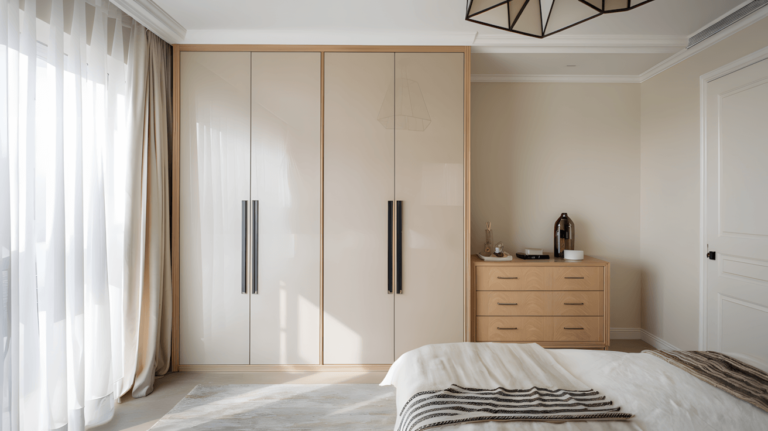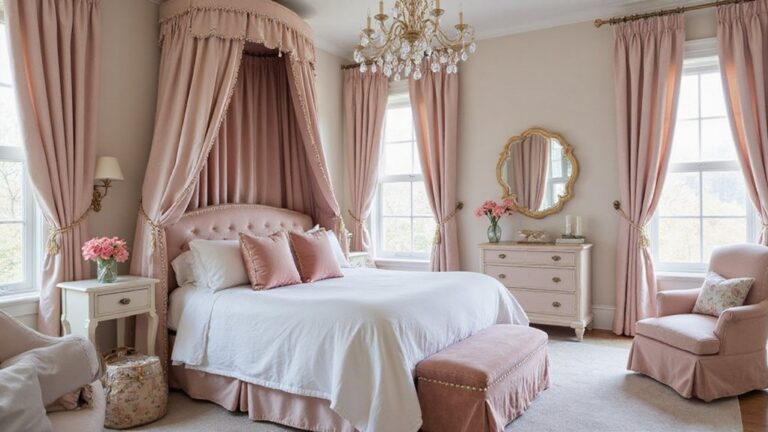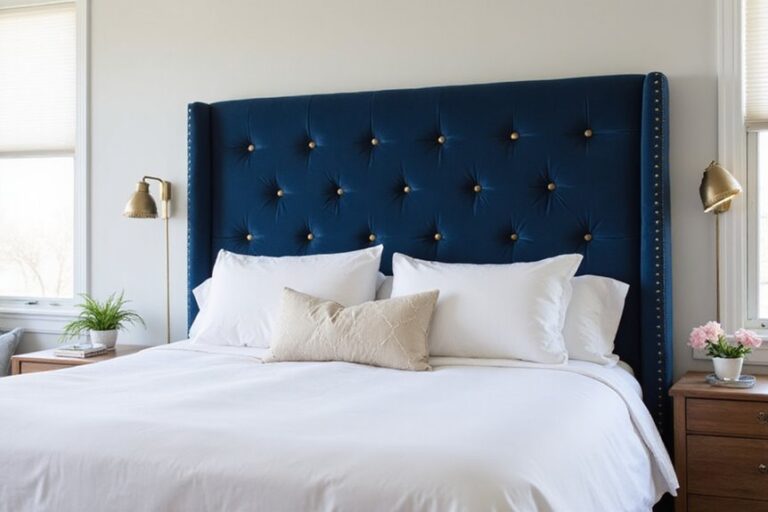Every parent knows that kids’ closets have a mysterious ability to transform from organized spaces into chaotic disaster zones faster than you can say “clean your room.” I’ve watched perfectly arranged children’s wardrobes descend into clothing avalanches that would make Marie Kondo weep—and honestly, the traditional adult organization methods just don’t cut it when you’re dealing with little humans who can barely reach the light switch.
The secret isn’t buying more bins or lecturing about tidiness (trust me, I’ve tried both). What actually works is creating a kid-friendly system that transforms organization from a parent-imposed chore into something children can actually maintain themselves. When you design closets around your child’s height, habits, and developmental stage, something magical happens—they start putting things away without being asked.
You’ll discover how strategic placement of clear bins at eye level, properly positioned hanging rods, and simple color-coding systems create lasting organization that grows with your child’s independence. These aren’t just storage solutions—they’re game-changing approaches that turn daily dressing routines from morning battles into smooth, autonomous victories.
Use Clear Bins and Labels for Easy Identification
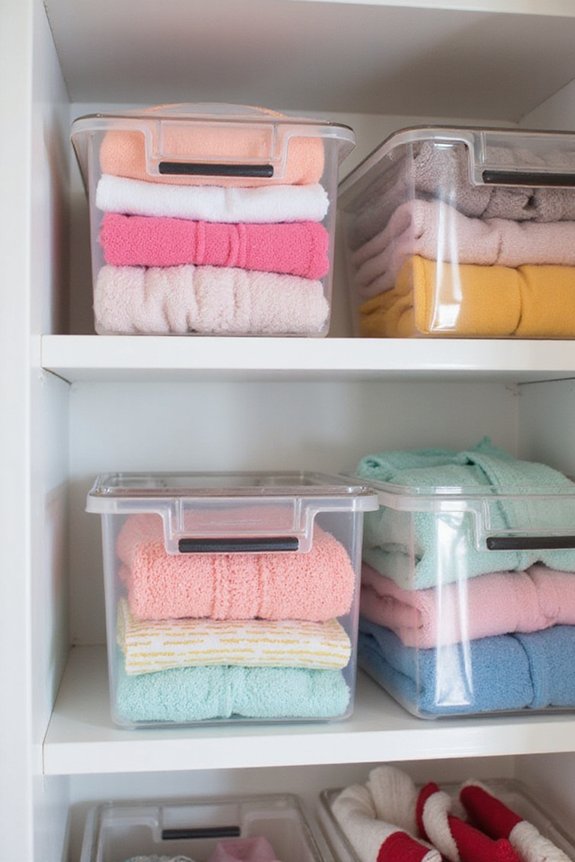
Chaos transforms into order when you implement clear storage bins throughout your child’s closet. You’ll instantly see what’s inside each container without opening lids or rummaging through contents. Add picture labels for non-readers and word labels for older children who can read independently.
Group similar items together: socks in one bin, underwear in another, hair accessories in a third. Position frequently used bins at your child’s eye level for easy access. Choose stackable containers to maximize vertical space while maintaining visibility. This system encourages kids to put items back where they belong, creating lasting organizational habits.
Install Low-Height Hanging Rods Within Child’s Reach
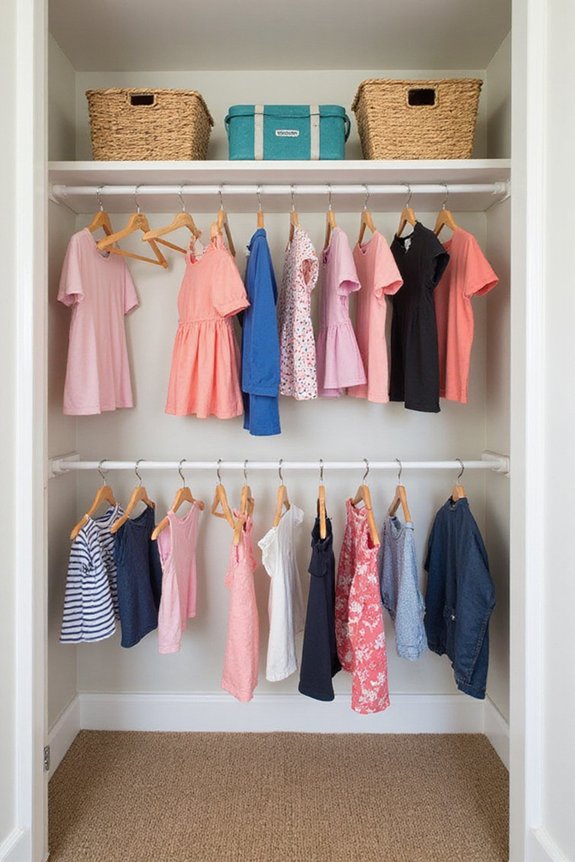
When you install hanging rods at your child’s height, you’re giving them direct control over their clothing choices and daily routines. Position rods 36-42 inches from the floor for toddlers and preschoolers, adjusting as they grow. This accessibility encourages independence and reduces morning struggles when they can dress themselves.
Consider installing adjustable rods that expand with your child’s height. Double-rod systems work well too – keep frequently worn items on the lower rod while storing seasonal clothing above. Your child will take ownership of their space when they can actually reach their clothes without assistance or frustration.
Create Designated Zones for Different Clothing Types
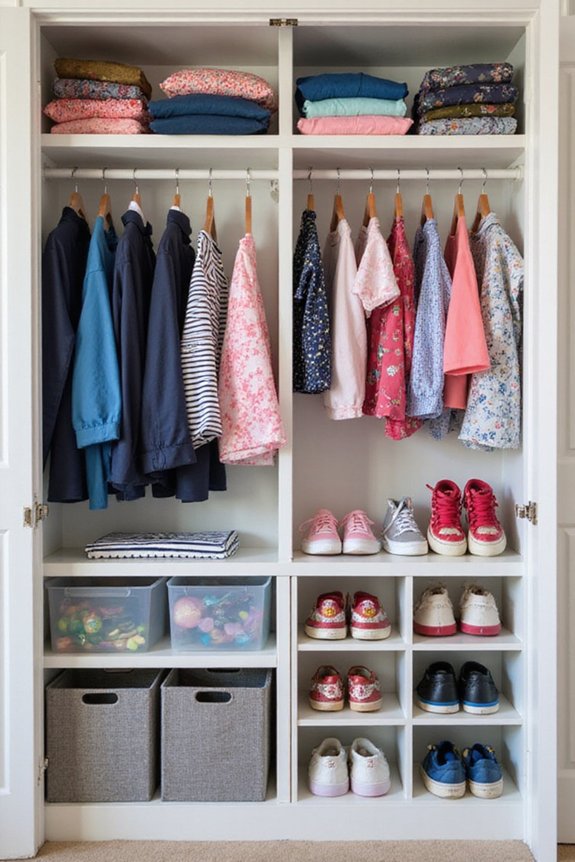
Why do mornings turn into treasure hunts when your child can’t find their favorite shirt? Creating designated zones eliminates this chaos by giving every clothing type its own home. Assign specific areas for school clothes, play clothes, pajamas, and special occasion outfits. Use shelf dividers, bins, or hanging organizers to maintain clear boundaries between zones.
Label each section with pictures and words so your child knows exactly where everything belongs. Place frequently used items like school uniforms in the most accessible spots. This system transforms your child’s closet into an organized space where they’ll actually find what they need.
Implement a Simple Color-Coding System
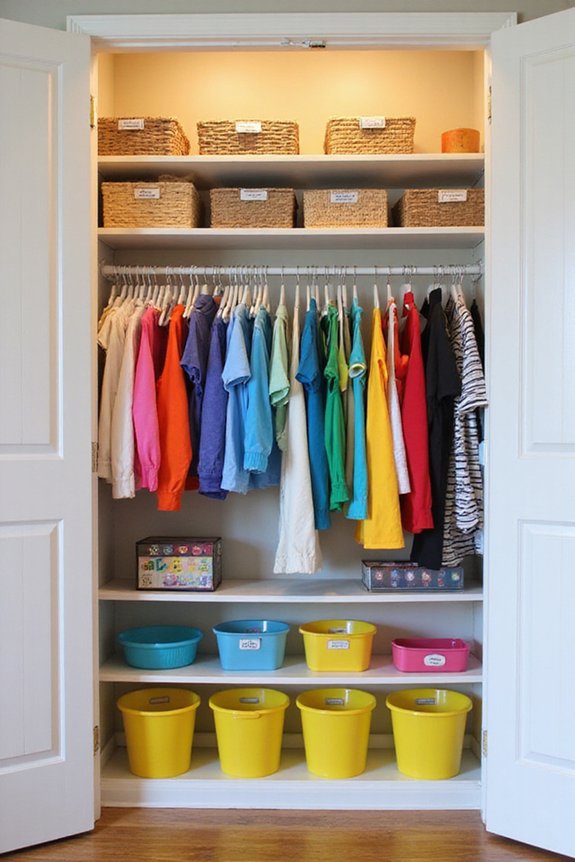
Color-coding instantly transforms closet chaos into visual order that even the youngest children can follow. Assign specific colors to different clothing categories—blue hangers for school clothes, red for play clothes, green for pajamas. Use colored bins or labels for accessories, socks, and underwear.
You can also implement seasonal color systems, switching colors when you rotate wardrobes. Involve your child in choosing colors for each category, making them more likely to maintain the system. This visual approach eliminates guesswork and creates an intuitive organization method that grows with your child’s independence and responsibility.
Add Pull-Out Drawers for Small Items and Accessories
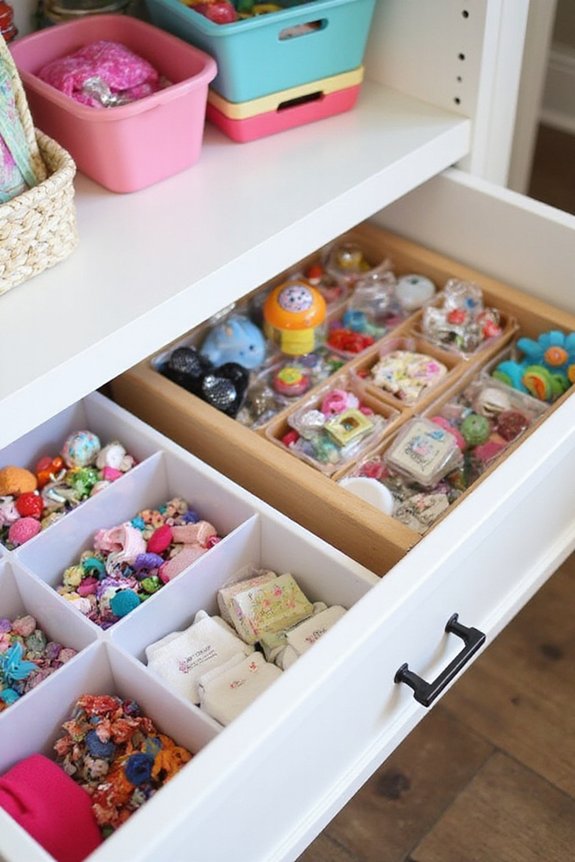
Small items like hair ties, jewelry, and socks disappear into closet black holes without proper containment. Pull-out drawers solve this problem by creating dedicated spaces for accessories and small clothing items.
Install shallow drawers at your child’s eye level so they can easily see and access their belongings. Use drawer dividers to separate different categories—one section for hair accessories, another for jewelry, and compartments for underwear and socks.
The sliding mechanism makes it simple for kids to pull out drawers completely, grab what they need, and push them back in without creating mess.
Use Over-the-Door Organizers for Maximum Storage
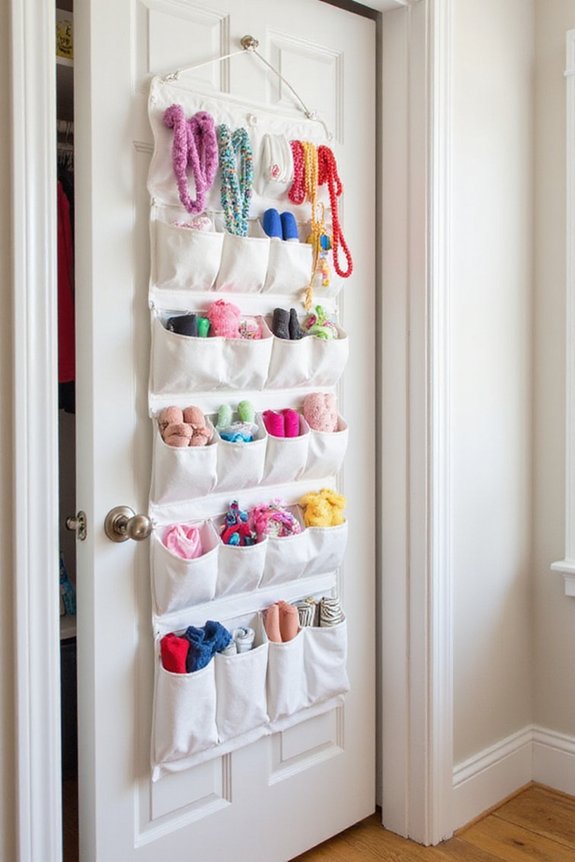
Every closet door represents untapped storage potential that can instantly double your organizational space. Over-the-door organizers transform unused vertical space into functional storage zones for your child’s belongings.
Choose clear shoe organizers with pockets to store small toys, craft supplies, hair accessories, and socks. Kids can easily see what’s inside each compartment, making cleanup faster. Install hooks for backpacks, jackets, or pajamas that need quick access.
Multi-pocket fabric organizers work perfectly for storing underwear, belts, or seasonal items. You’ll maximize every inch of closet space while keeping frequently used items within your child’s reach for independent organization.
Install Adjustable Shelving That Grows With Your Child
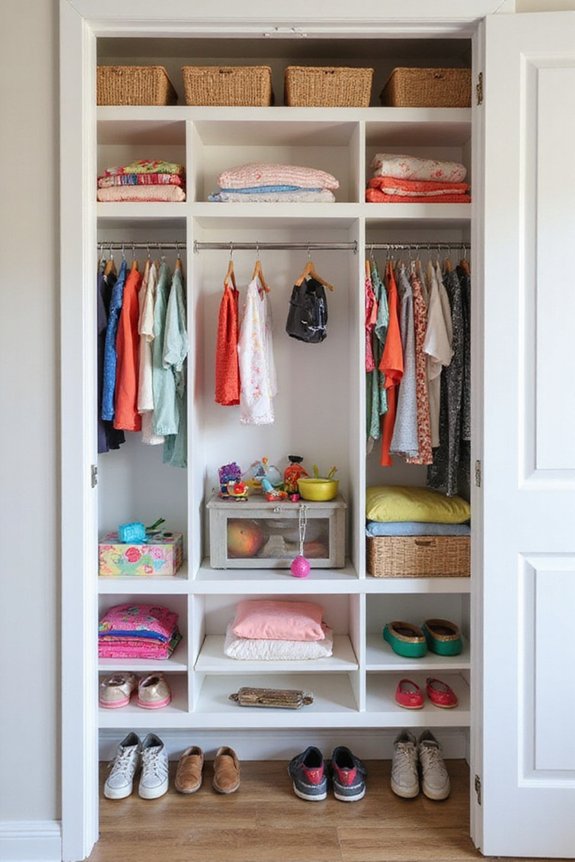
While door organizers maximize your vertical space, adjustable shelving systems create the flexible foundation your child’s closet needs for years to come. These versatile solutions adapt as your child grows, eliminating the need for complete closet overhauls.
Consider these key benefits of adjustable shelving:
- Height flexibility – Move shelves up or down as your child grows taller
- Changing storage needs – Accommodate toys, then books, then sports equipment
- Cost efficiency – One system lasts from toddler to teen years
- Easy reconfiguration – Adjust spacing for seasonal clothing changes
You’ll save money and maintain organization by investing in quality adjustable systems upfront.
Create a Daily Outfit Planning Station
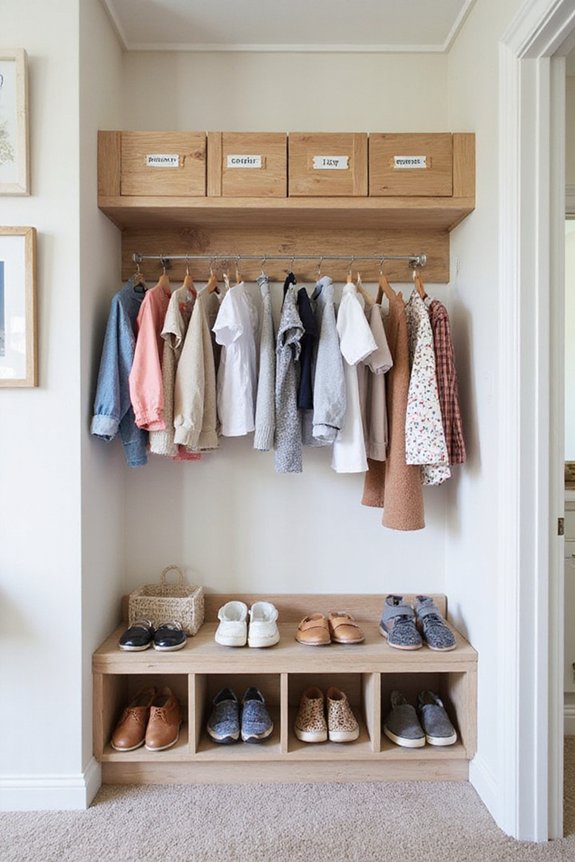
How often does your child stand bewildered in front of their closet each morning, cycling through outfit after outfit while you’re rushing to get everyone ready? Install a dedicated outfit planning station to eliminate this daily chaos.
Mount five labeled hooks at your child’s height for each weekday, allowing them to pre-select complete outfits on Sunday evenings. Include a small basket below for accessories like socks and hair ties. Add a mirror nearby so they can visualize their choices.
This system transforms frantic mornings into smooth routines while teaching your child valuable planning skills and independence.
Use Cube Storage Systems for Toys and Seasonal Items
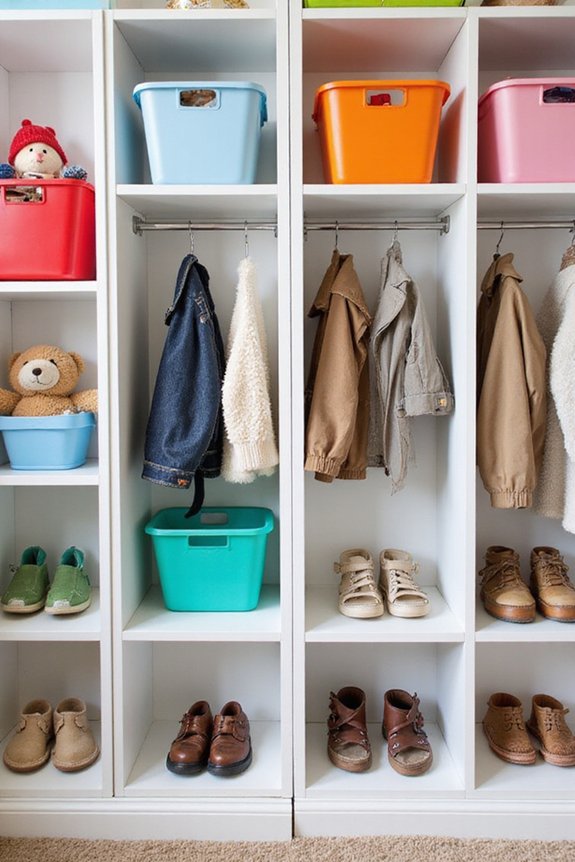
Although traditional toy boxes create cluttered black holes where items disappear, cube storage systems offer visible, accessible organization that transforms your child’s closet into a functional space. You can designate specific cubes for different categories while maintaining easy access.
Maximize your cube storage effectiveness with these strategies:
- Label each cube with pictures and words for easy identification
- Store seasonal clothing in upper cubes with clear bins
- Dedicate lower cubes to frequently used toys and games
- Use fabric bins that fit perfectly within each cube compartment
This system grows with your child and adapts to changing storage needs effortlessly.
Implement the One-In-One-Out Rule for Clothes Management
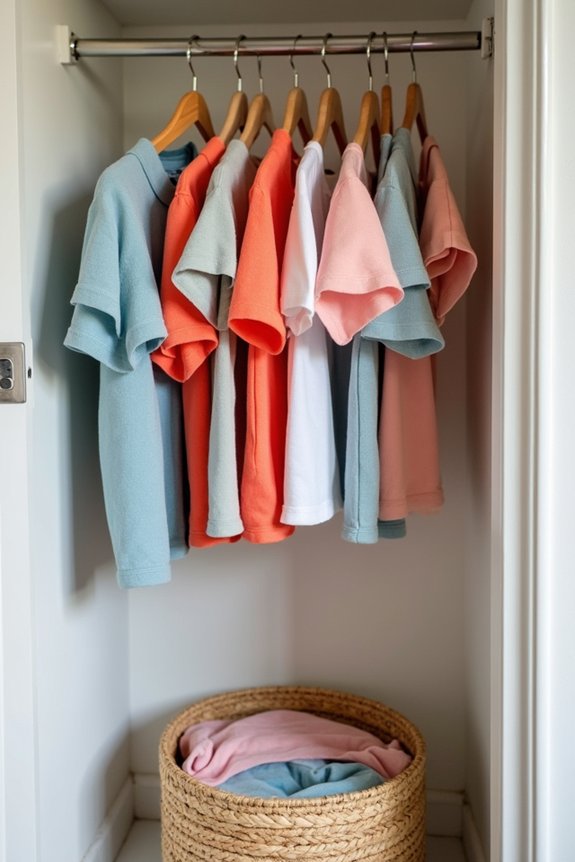
Since children’s clothing needs change rapidly as they grow, implementing a one-in-one-out rule prevents closets from becoming overwhelmed with outgrown or unworn items. You’ll establish this system by removing one piece whenever you add something new to your child’s wardrobe. This practice maintains consistent inventory levels while teaching kids valuable lessons about mindful consumption.
Start by involving your child in decision-making about which items to donate or store. They’ll develop ownership over their belongings and understand space limitations. You’ll find this rule particularly effective during back-to-school shopping or holiday gift seasons when new clothes typically flood closets.
Add Good Lighting to Make Everything Visible
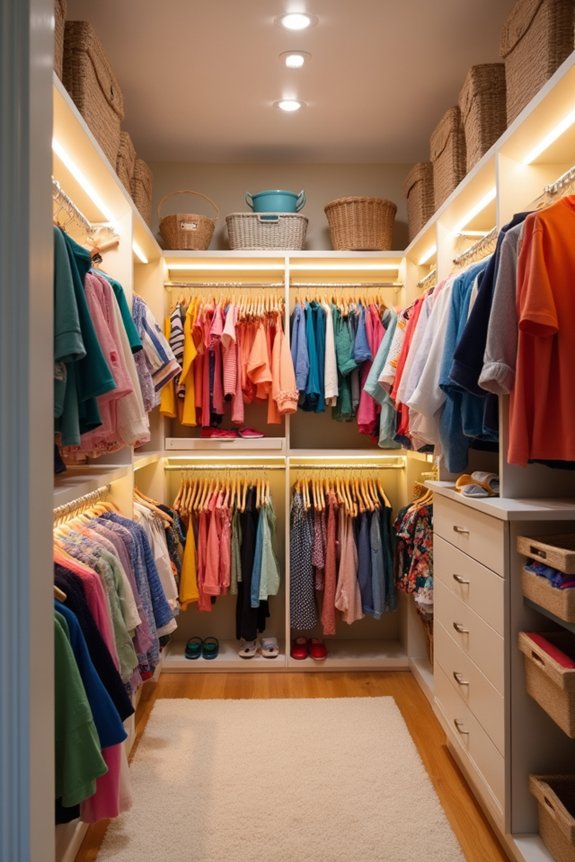
When your child’s closet lacks adequate lighting, they’ll struggle to see clothing options clearly and make quick outfit decisions. Poor visibility leads to wrinkled clothes being pulled from hangers and items getting lost in dark corners.
Transform your child’s closet with these lighting solutions:
- Install LED strip lights under shelves and along hanging rods for even illumination
- Add battery-operated puck lights in corners and on upper shelves for targeted brightness
- Mount a motion-sensor light that automatically turns on when the door opens
- Use a small LED closet light bar that plugs into nearby outlets for instant brightness
Good lighting makes organization maintenance effortless.
Create a Weekly Closet Reset Routine
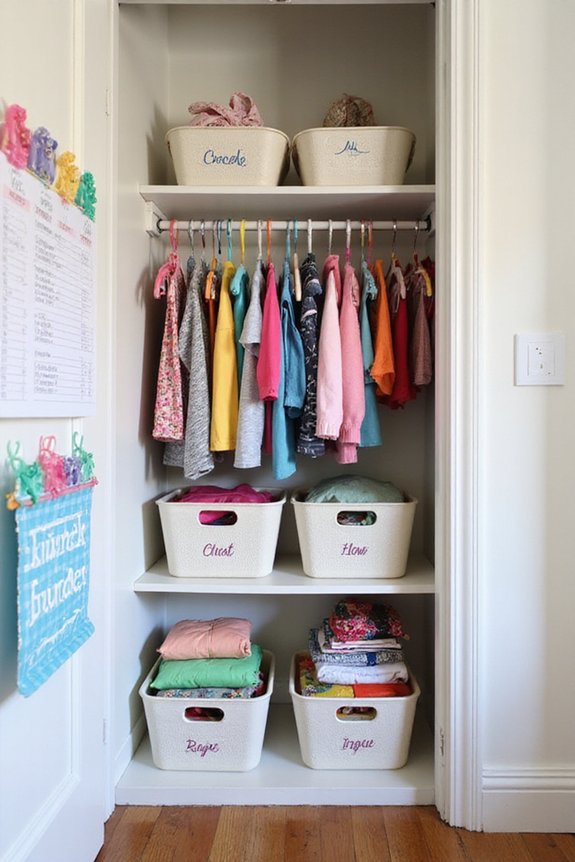
Even the most thoughtfully organized kids’ closet will gradually fall into chaos without regular maintenance. You’ll need to establish a weekly reset routine to keep everything functioning smoothly. Pick a consistent day, like Sunday evening, to tackle the task together with your child.
Start by returning misplaced items to their designated spots. Hang up clothes that’ve fallen, refold messy drawer contents, and put shoes back in their bins. Check for outgrown items or damaged clothing that needs removal. This fifteen-minute weekly investment prevents major organizational breakdowns and teaches your child valuable maintenance habits they’ll use throughout their lives.
Conclusion
You’ve now got the blueprint for transforming your child’s closet from chaos into calm. These organization systems aren’t just pretty solutions—they’re practical tools that’ll grow with your kids and actually stick. Remember, you’re not just organizing clothes; you’re teaching life skills that’ll serve them well beyond childhood. When you implement these strategies consistently, you’ll find that maintaining order becomes second nature for the whole family.


